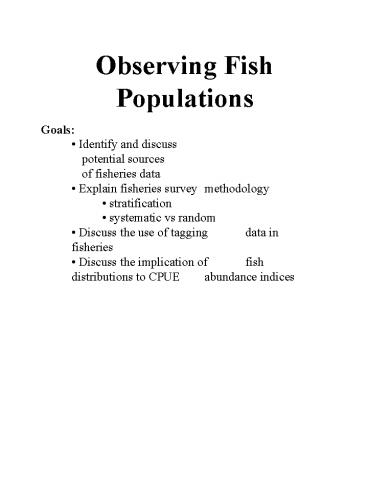Observing Fish PowerPoint PPT Presentation
1 / 15
Title: Observing Fish
1
Observing Fish Populations
- Goals
- Identify and discuss potential sources of
fisheries data - Explain fisheries survey methodology
- stratification
- systematic vs random
- Discuss the use of tagging data in fisheries
- Discuss the implication of fish distributions
to CPUE abundance indices
2
A Simple Problem In Fisheries Management
Communication
- Keep Informal communication open
- Know where numbers come from
3
Sources of Data
4
Observed Data
- Encounter rates
- CPUE
- estimate N and or F
- count per transect
- Sampled Catch
- Age estimates
- from hard parts
- validation important
- length
- weight
- reproductive condition
- genetics, morphometrics
- stomach contents
- Location
- infer movement
5
Data From Commercial Fisheries
- Observers
- assume fishing unchanged
- usefully for discard studies
- difficult to randomly subsample
- Port Sampling/Creel Survey
- collected from processors
- collected by agent
- tends to aggregate spatially and temporally
- Log Books
- assume accurate reporting
- lacks detailed age/spp. data
- can get detailed spatial data
- potentially high coverage
6
Patterns in Commercial CPUE
CPUE
c.
b.
a.
Abundance
- a. Proportional
- ideal situation
- b. Hyperstable (CPUE poor index)
- constant density in schools
- handling time constraints
- c. Hyperdepletion (CPUE safe index)
- refuge (area, size, etc.)
7
Suggested Use of Commercial Catch and Effort Data
- Map the CPUE values
- sketch CPUE distribution
- Know your fishery
- how is it conducted?
- how could this influence CPUE?
- Use additional information if possible
- fish movements between areas
- tagging studies
- survey data
- operational studies of fishing gear
- DO NOT USE CPUE TO CALCULATE
- A SINGLE, SIMPLE INDEX OF
ABUNDANCE!!!
8
Research Surveys
- Use dedicated equipment or charters
- Expensive (operating expenses)
9
Survey Characteristics
10
Survey Design
- Stocks range is often heterogeneous
- different bottom types
- different currents
- different gear efficiencies
- Stratification
- A stratum is defined to be more homogeneous
than the whole area sampled - Results in more precise estimates
- if variation within stratum is less than random
sample over whole survey area
11
Stratum Boundaries
- set apriori
- should not be changed within survey season
- stratum boundary becomes non-random
- may bias variation estimate (appear too
uniform) - can redefine strata between survey seasons
- BUT caution for comparisons between seasons
- INDEX weighted mean of strata
- proportional to stratum area
- inversely proportional to stratum uncertainty
12
Systematic vs Random Sampling
- Systematic PROS
- efficient to implement
- better for mapping
- minimize risk of missing aggregations
- facilitates comparisons between survey seasons
- more precise Iff Var among obs. is greater than
random obs.
- Systematic CONS
- easily biased by gradients
- precision not easily defined
- resample
- IN CONTRAST standard error easily estimated for
random samples
13
Random designs can beimplemented on large scales.
- First Time Survey Design in Stages
- first pass define strata
- fast, rough (sonar?)
- second stage estimate abundance
- more precise gear/protocol
- weighted estimate
- third stage / more stages
- subsample or resample as required for research
questions
14
Research Tagging
- Used to estimate
- abundance
- survival
- movement
- fishing mortality
- Usually very expensive
- 5,000 per yellowfin tag return for South
Pacific Tuna Comm. - more expensive with trackable tags
- Low emphasis on collection
- Hard to determine Parameters
- tag related mortality
- tag shedding
15
Some Tagging Issues
- Double Tagging to estimate
- shedding rate
- tagging mortality
- Post-tagging holding
- estimate tagging mortality
- why might this not work well??
- Tag under reporting
- agent sampling of catches
- statistical techniques
- reward programs
- Not recommended for abundance
- Recommended for movement

